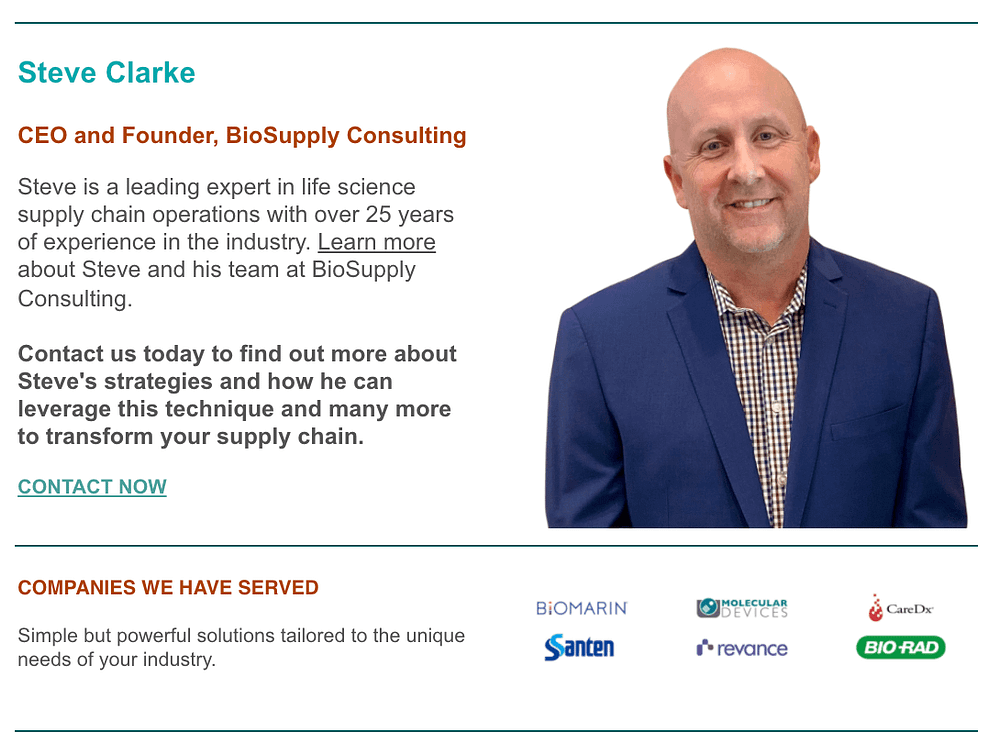LIFE SCIENCE SUPPLY CHAIN SOLUTIONS BY STEVE CLARKE
Challenge
For those of you that read previous newsletters, you will know that last week I led a kaizen event to bring inventory under control at a life science client.
From a space utilization standpoint, here were the key numbers:Inventory on hand = 200 palletsWarehouse capacity = 44 palletsOverflow inventory = 156 pallets This overflow inventory was in the aisles, in offices, walkways, trailers, it was everywhere! In short, there were very few places on site where inventory could not be found. It had been like this on and off for years, but it had not been properly addressed, since it takes a concerted effort to tackle the root causes, and there is always something more urgent to focus upon.
Solution
A kaizen event creates that concerted, cross-functional effort to not only create some order, but to address what caused the inventory to accumulate, in the first place.
The first step was to obtain data on items with no transaction history in the past 6 months. The team removed these items from the shelves and consolidated them. This removed about the equivalent of 10 pallet spaces, so clearly much more needed to be done. We then planned to identify and remove excess inventory, where we had more than 2 years on hand, based up recent demand. However, as we spent time immersed in the weeds, our understanding of the opportunities become much clearer.
In this case, the client had recently installed an expensive Vertical Life Module (VLM). A VLM is a “goods-to-person” picking solution that allows users to pick orders very efficiently while optimizing space utilization within a facility. It is essentially a vertical carousel full of small trays. We learned that the VLM was less than 50% utilized, which presented a great opportunity to remove items from the floor. The VLM is limited in the size of items it can store, so we made the decision to painstakingly go through every box to determine whether it could fit on the VLM or whether it required another storage solution. For the items that were too large for the VLM, we stacked them in the racks or on mobile carts if the item cubic space was small.
As the small items were removed, it became clear that some bulky items, such as packaging had an inordinate amount of inventory. The purchasing representative on the team was asked to investigate why we had purchased so much of these items, and report back with explanations and suggest controls to prevent such an inventory build up in future. In addition, based upon average usage per month, we calculated how quickly the excess inventory would “bleed off”
For example, one item alone had 28 pallets, which equated to about 3 months on hand. Since it was a packaging item, with multiple possible vendors, it would not be difficult to negotiate with the supplier for them to maintain inventory at their site, and reduce their minimum order quantity. In addition, reorders would be switched to a kanban system to further tighten inventory controls. In summary, the future target inventory was reduced to 5 pallet spaces from 28 pallets. Since about 10 pallets were consumed per month, the target should be achieved in less than 3 months
Testimonial
“Excellent with lean manufacturing and kaizen.”
~ Roy Hendricks, Senior Buyer
Results
The kaizen objectives were as follows:1. Identify and remove 100% of inactive items2. Reduce site overflow inventory from 200 pallets to 0 pallets The first objective is complete. For now, the inactive items are in outside trailers until we can clearly differentiate items that are truly obsolete. In terms of the 2nd objective, this was delayed due to the need to sort through every item to see whether it could be stored in the VLM. However, by the end of this week we should have achieved this objective. The controls being put in place to prevent further accumulation of large bulky items will mean that all the good work will not be gradually undone. I will continue to report on our progress as we continue to make sense of the chaos.



